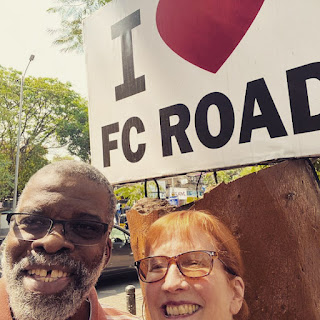At our second meeting of the Jane Austen Book Club (JABC) I wanted to make scones. I thought the British tradition might transport us to Jane Austen’s time. However, I lacked several ingredients and tools needed to make scones. I don’t have an oven; I couldn’t get white flour, and vanilla extract is prohibitively expensive. So I “made do.” I’ve been doing that a lot during the past two months in India. One of the young ladies in the JABC informed me that “making do” is a very Indian proposition — so much so that there is a word for it— jugaad. Jugaad means making do. Jugaad is making something using what is available. Jugaad, or improvising, is a very common Indian practice. Instead of using an oven, I used the microwave/convection oven. Instead of using white flour, I used almond flour. I omitted the vanilla extract. Instead of zesting the orange peel, I used a knife to cut it into tiny pieces. The cranberry orange scones were not quite as big and fluffy as usual, but they were tasty! Jugaad!
In other areas of my life I have used jugaad— here are just a few. In the kitchen: At home, I have a large variety of implements and utensils (grater, peeler, zester); a variety of knives; many pots, pans, and baking sheets; a toaster, blender, and mixer; and all kinds of spatulas and large spoons. Here I have one small knife; forks, spoons, and knives; one pot, one pan, and a bowl. That’s it! We make toast in the pan—it’s convenient to fry an egg on one side and toast bread on the other; if you don’t have a spatula, use a common table knife; get some exercise and beat your batter or cream by hand. I can make simple meals with what I have.Technology: One classroom I use has no technology— no computer or projector. The other room, pictured at right, has computers that sometimes work.
There are ways to teach with technology without having technology in the classroom. No, that’s not antithetical. To use a PowerPoint in the classroom, I use Nearpod. It’s an app where students can view PowerPoints on their phones. They can also take polls (PollEverywhere) and quizzes (Kahoot or Socrative) on their phones, and contribute to word clouds (Answer Garden). Even if the power goes out, which it frequently does but usually not for very long, we can still access our phones. Once when I was teaching Research Methodology the power went out for about 45 minutes. I opened the doors to let the breeze cool us off, as the ceiling fans had stilled. My laptop still had power and I was connected to WiFi, so I held up my laptop and continued to teach. We don’t let small inconveniences like a lack of power stop us from teaching and learning!My husband Bill and I have learned to practice jugaad in several other ways while living here in India (or just a simpler lifestyle): we wash our clothes by hand in a bucket; my hair gets a blow-dry on the rickshaw ride to school; if the power goes out our phones have a flashlight; paper clips can be used as screwdrivers; cold showers are refreshing; if you run out of bug spray, invite some lizards in, or turn up the AC and dive under the covers; if you can’t make copies of documents….. no, I draw the line there. I’m not going back to the days of monks and copying a document by hand 20 times! If all else fails, take a nap! Please add your own jugaad fixes in the comments below!










